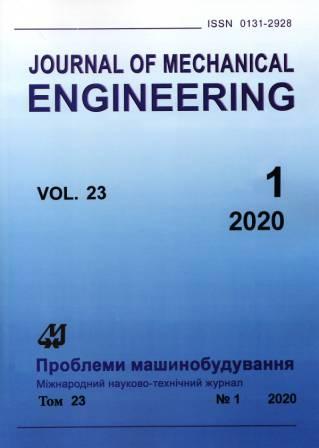Метод исследования ползучести функционально-градиентных тел сложной формы
Ключевые слова:
функционально-градиентный материал, тело вращения, ползучесть, метод R-функцийАннотация
Рассмотрена задача ползучести тел вращения сложной формы из функционально-градиентных материалов. Для вариационной постановки задачи используется функционал в форме Лагранжа, заданный на кинематически возможных скоростях перемещений. Разработан численно-аналитический метод решения нелинейной начально-краевой задачи ползучести, который базируется на совместном использовании методов R-функций, Ритца и Рунге-Кутта-Мерсона. К преимуществам предложенного метода можно отнести: точный учет геометрической информации о краевой задаче на аналитическом уровне, без какой-либо ее аппроксимации, представление приближенного решения задачи в аналитическом виде, автоматический выбор временного шага. Решены задачи ползучести полого цилиндра и тела вращения сложной формы – цилиндра с прямоугольным вырезом на наружной поверхности, нагруженных постоянным внутренним давлением, выполненных из функционально-градиентного материала на основе алюминия, армированного частицами карбида кремния SiC. Ползучесть материала описывается законом Нортона. Модуль Юнга и характеристики ползучести зависят от объемной части армирующего материала. Оба конца цилиндра свободны от внешней нагрузки и закреплены таким образом, что радиальные перемещения равны нулю. Построена соответствующая частичная структура решения, удовлетворяющая граничным условиям для скоростей перемещений. Расчеты выполнены для цилиндров из двух различных композиционных материалов – материала с однородным распределением SiC-частиц и функционально-градиентного материала c перепадом объемного содержания армирующих частиц вдоль радиуса. При этом среднее значение объемного содержания армирующих SiC-частиц в двух случаях было одинаковым. Исследовано влияние градиентных свойств материала и геометрической формы на напряженно-деформированное состояние при ползучести. Наличие на внешней поверхности цилиндра прямоугольного выреза приводит во всех случаях к увеличению перемещений и напряжений. При этом степень влияния геометрической формы на напряженно-деформированное состояние при ползучести существенно зависит от градиентных свойств материала. Для цилиндра с вырезом, выполненного из материала с однородным распределением SiC-частиц, наблюдается значительный рост перемещений и напряжений после 100 часов ползучести, по сравнению с прямым цилиндром. Для тел, выполненных из функционально-градиентного материала, влияние выреза на напряженно-деформированное состояние менее выражено.Библиографические ссылки
Chen, J. J. (2007). Creep analysis for a functionally graded cylinder subjected to internal and external pressure. J. Strain Analysis, vol. 42, pp. 69–77. https://doi.org/10.1243/03093247JSA237.
Nejad, M. Z. & Kashkoli, M. D. (2014). Time-dependent thermo-creep analysis of rotating FGM thick-walled cylindrical pressure vessels under heat flux. Int. J. Eng. Sci., vol. 82, pp. 222–237. https://doi.org/10.1016/j.ijengsci.2014.06.006.
Shrikant, K. V. (2012). Creep analysis of an isotropic functionally graded cylinder. J. Advances in Sci. and Techn., vol. 3, no. 4, pp. 1–9.
Singh, T. & Gupta, V. K. (2011). Effect of anisotropy on steady state creep in functionally graded cylinder. Composite Structures, vol. 93, no. 2, pp. 747–758. https://doi.org/10.1016/j.compstruct.2010.08.005.
Chen, J. J., Yoon, K. B., & Tu, S. T. (2011). Creep behavior of pressurized tank composed of functionally graded materials. J. Pressure Vessel Techn., vol. 133, pp. 69–77. https://doi.org/10.1115/1.4003455.
Kashkoli, M. D. & Nejad, M. Z. (2015). Time dependent thermo-elastic creep analysis of thick-walled spherical pressure vessels made of functionally graded materials. J. Theoret. and Appl. Mech., vol. 53, no. 4, pp. 1053–1065. https://doi.org/10.15632/jtam-pl.53.4.1053.
Breslavskyi, D. V., Korytko, Yu. M., & Tatarinova, O. A. (2017). Proektuvannia ta rozrobka skinchennoelementnoho prohramnoho zabezpechennia [Design and development of finite element software]. Kharkiv: «Pidruchnyk NTU «KhPI», 232 p. (in Ukrainian).
Breslavsky, D., Kozlyuk, A., & Tatatarinova, O. (2018). Numerical simulation of two-dimensional problems of creep crack growth with material damage consideration. Eastern-European Journal of Enterprise Technologies, no. 2/7 (92), pp. 27–33. https://doi.org/10.15587/1729-4061.2018.119727.
Rvachev, V. L. (1982). Teoriya R-funktsiy i nekotoryye yeye prilozheniya [The R-functions theory and some of its applications]. Kiyev: Naukova Dumka, 552 p. (in Russian).
Rvachev, V. L. & Sinekop, N. S. (1990). Metod R-funktsiy v zadachakh teorii uprugosti i plastichnosti [The R-functions method in problems of the theory of elasticity and plasticity]. Kiyev: Naukova dumka, 216 p. (in Russian).
Rodichev, Y. M., Smetankina, N. V., Shupikov, O. M., & Ugrimov, S. V. (2018). Stress-strain assessment for laminated aircraft cockpit windows at static and dynamic loads. Strength of Materials, vol. 50, iss. 6, pp. 868–873. https://doi.org/10.1007/s11223-019-00033-4.
Smetankina, N. V. (2015). Modeliuvannia kolyvan sharuvatykh tsylindrychnykh obolonok skladnoi formy pry udar-nomu navantazhenni [Modeling of oscillations of layered cylindrical shells of complex shape at impact loading]. Visn. Zaporiz. nats. un-tu. Fizyko-matematychni nauky – Bulletin of Zaporizhzhya National University. Physical and mathematical sciences, no. 1, pp. 162–170 (in Ukrainian).
Zolochevsky, A., Sklepus, S., Galishin, A., Kühhorn, A., Kober, M. (2014). A comparison between the 3D and the Kirchhoff-Love solutions for cylinders under creep-damage conditions. Techn. Mechanik, vol. 34, no. 2, pp. 104–113.
Singh, S. B. & Ray, S. (2003). Creep analysis in an isotropic FGM rotating disc of Al–SiC composite. J. Materials Proc. Techn., vol. 143–144, pp. 616-622. https://doi.org/10.1016/S0924-0136(03)00445-X.
Ogierman, W. & Kokot, G. (2013). Mean field homogenization in multi-scale modelling of composite materials. J. Achievements in Materials Manufacturing Eng. (JAMME), vol. 61, iss. 2, pp. 343–348.
Singla, A., Gard, M., & Gupta, V. K. (2015). Steady state creep behaviour of functionally graded composite by using analytical method. Intern. J. Computer Appl., no. 8, pp. 13–17.
Загрузки
Опубликован
Выпуск
Раздел
Лицензия
Copyright (c) 2020 Serhii M. Sklepus

Это произведение доступно по лицензии Creative Commons «Attribution-NoDerivatives» («Атрибуция — Без производных произведений») 4.0 Всемирная.
Авторы, публикующиеся в этом журнале, соглашаются со следующими условиями:
- Авторы оставляют за собой право на авторство своей работы и передают журналу право первой публикации этой работы на условиях лицензионного договора (соглашения).
- Авторы имеют право заключать самостоятельно дополнительные договора (соглашения) о неэксклюзивном распространении работы в том виде, в котором она была опубликована этим журналом (например, размещать работу в электронном хранилище учреждения или публиковать в составе монографии), при условии сохранения ссылки на первую публикацию работы в этом журнале.
- Политика журнала позволяет размещение авторами в сети Интернет (например, в хранилищах учреждения или на персональных веб-сайтах) рукописи работы, как до подачи этой рукописи в редакцию, так и во время ее редакционной обработки, поскольку это способствует возникновению продуктивной научной дискуссии и позитивно отражается на оперативности и динамике цитирования опубликованной работы (см. The Effect of Open Access).

